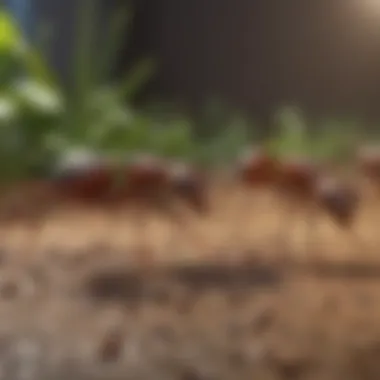Effective Strategies for Eliminating Crazy Ants


Intro
Understanding the Pest
Identification
Identifying crazy ants accurately is the first step in combatting their invasion. Crazy ants can be distinguished by their size and color. They are generally small, measuring around 2.5 to 3 mm in length and exhibit a dark brown to black coloration. One of the most distinctive features is their erratic movement. Unlike other ant species, crazy ants scurry rather than follow a straight line. Their antennae are also relatively longer compared to their body size, which adds to their unique appearance.
Key Characteristics:
- Size: 2.5 to 3 mm long
- Color: Dark brown to black
- Movement: Erratic and scurrying
- Antennae: Long and straight
Life Cycle
The life cycle of crazy ants involves several stages: eggs, larvae, pupae, and adults. The queen can produce thousands of eggs in her lifetime, contributing to rapid population growth. Understanding this cycle is crucial for effective control, as interventions must target multiple developmental stages.
- Eggs: Not visible to the naked eye and hatch within a few days.
- Larvae: White and grub-like, they feed on materials provided by worker ants.
- Pupae: The pupal stage can last up to several weeks, depending on environmental conditions.
- Adults: Reach maturity within about 30 days after hatching, leading to quick reinfestations if not managed properly.
Pest Prevention Strategies
Preventing crazy ant infestations starts with modifications to the environment and implementing physical barriers.
Environment Modification
Modifying the environment includes practices that reduce the likelihood of crazy ants moving in. This may involve:
- Eliminating food sources: Keep food sealed and remove spills promptly.
- Clearing clutter: Dispose of unnecessary items that may provide shelter.
- Water management: Fix leaks and remove standing water, as crazy ants are attracted to moisture.
Physical Barriers
Implementing physical barriers is an effective strategy to hinder crazy ant entry. Homeowners can:
- Seal cracks and openings: Use caulk or foam to close gaps around windows and doors.
- Install door sweeps: Ensure doors fit tightly to the thresholds to prevent entry.
- Create a buffer zone: Maintain a clean buffer zone around the house, free of mulch or debris, that can harbor ants.
Control Methods
When prevention fails, control methods must be implemented. Both chemical and biological controls can be effective against crazy ants.
Chemical Control
Chemical control methods include the application of insecticides to destroy existing populations. Baiting systems can be effective as they attract ants and allow them to carry poison back to the colony. It's crucial to choose eco-friendly options that do not harm beneficial insects.
Biological Control
Biological methods utilize natural predators or pathogens to manage pest populations. This may include:
- Using parasitic wasps that prey on ants.
- Introducing nematodes which can infect and kill ant larvae.
Successful management of crazy ants requires an integrated approach that combines both prevention and control strategies to maintain a pest-free environment.
Intro to Crazy Ants
Crazy ants, notorious for their erratic movement, pose multifaceted challenges for homeowners. Understanding their behavior and origins is pivotal for effective management strategies. This section serves as a foundation, offering insights into why knowing crazy ants is essential.
Crazy ants, most commonly the Paratrechina longicornis, have become increasingly prevalent, particularly in warmer climates. Their ability to form large colonies and exhibit invasive behaviors underlines the urgency of effectively managing their populations. Failure to address an infestation can lead to substantial ecological disruption, impacting both local flora and fauna. Hence, recognizing these ants' distinctive characteristics and behaviors is crucial for homeowners aiming to maintain a pest-free environment.
Understanding Crazy Ant Behavior


The behavior of crazy ants is anomalous compared to many other ant species. They display frantic, erratic movements, often appearing disoriented. This characteristic is not just for show; it plays an important role in how they interact with their environment and how they evade predators.
These ants are driven by a social structure that enhances colony survival. They communicate through pheromones, which guide worker ants to food sources or warn of danger. Their foraging behavior is aggressive, leading them to exploit whatever resources are available. Importantly, crazy ants are also attracted to electrical equipment, which can cause significant harm, especially in urban settings.
Origin and Impact on Ecosystems
Crazy ants originated in Southeast Asia but have spread to various continents due to international trade and climate changes. Their establishment in new environments often facilitates ecological imbalance. They outcompete native ant species, which can lead to declines in native populations. This displacement not only affects the local insect community but can also have cascading effects on plant species that depend on those insects for pollination or pest control.
Moreover, their affinity for regions dominated by human activity suggests that urban environments become a primary battleground for these invasive species. As homeowners encounter crazy ants, understanding their origins and ecological impacts becomes crucial in framing targeted response strategies. Awareness and knowledge empower communities to take action, making strategic management of crazy ants not just necessary but vital to preserving local ecosystems.
Identifying Crazy Ants
Identifying crazy ants is a crucial step in managing these invasive pests effectively. Understanding their physical characteristics and behavior can lead to timely intervention, preventing major infestations. Proper identification helps homeowners and pest control professionals differentiate crazy ants from other ant species, which is vital for applying the correct control strategies. It reduces potential harm to beneficial insects and minimizes the use of unnecessary pesticides.
Physical Characteristics
Crazy ants are distinct in appearance compared to other ant species. They typically have a slender, elongated body, which can vary in color from dark brown to black. One important feature is the lack of spines on their bodies, setting them apart from other ants like fire ants. Their antennae are typically long and bend at an angle.
Their legs are relatively long, contributing to their erratic and quick movement. This behavior is what gives them their name. When observing these ants, note:
- Size: Adult crazy ants generally range from 2.5mm to 5mm in length.
- Color: They exhibit a shiny surface, often making them appear somewhat iridescent.
- Body Structure: Their bodies are smooth and lack any pronounced points or spines.
To effectively identify a crazy ant, thorough observation is required. If you spot these characteristics, it’s likely you are dealing with an infestation of crazy ants.
Behavioral Signs of Infestation
The behavior of crazy ants provides clear indicators of their presence. They are known for their fast, erratic movements, making them quite noticeable. Observing nesting behavior is also significant. Crazy ants tend to create nests in various locations, often in damp areas.
Signs that suggest a crazy ant infestation include:
- Trail Patterns: Crazy ants leave behind trails, which can sometimes be seen leading towards food sources.
- Unusual Scattering: Unlike typical ant behavior of structured trails, crazy ants may appear scattered and aimless.
- Frequent Activity: Increased sightings, especially near food sources or in hidden areas like wall voids, can indicate a larger problem.
By recognizing these behavioral signs early, homeowners can act before an infestation worsens, making control measures more effective.
Detecting crazy ants promptly can save homeowners stress and potential damage to their property. Identifying these pests can set the stage for more targeted and efficient management strategies.
Choosing an Effective Control Strategy
Selecting a suitable control strategy for dealing with crazy ants is crucial in managing their populations effectively. The importance lies in combining various methods to achieve a more comprehensive approach. Homeowners need to balance efficiency and safety, ensuring that the techniques applied do not harm pets or the environment. This section explores chemical and non-chemical methods, providing insight into how each plays a vital role in controlling crazy ants in residential spaces.
Chemical Control Methods
Types of Chemical Insecticides
Chemical insecticides are often the first line of defense against crazy ants. These substances disrupt the normal biological functions of insects, leading to their demise. Common types include pyrethroids and neonicotinoids. Each has unique properties that contribute to its effectiveness.
- Key characteristic: The fast action of pyrethroids makes them a popular choice among homeowners. Their ability to quickly incapacitate insects is beneficial when dealing with large infestations.
- Unique feature and advantages: Pyrethroids bind effectively to sodium channels in the insect nervous system. However, readers should also consider that their overuse can lead to resistance.
Application Techniques
Proper application techniques are equally important in maximizing the effectiveness of chemical control methods. The methods used can dictate how well the treatment will work against crazy ants.
- Key characteristic: Using spot treatments instead of broad applications can prevent unnecessary exposure to non-target organisms. This makes treatments both efficient and environmentally friendly.
- Unique feature and advantages: Spot treatments involve applying the insecticide directly to areas where ant activity is noted. This directs the effort where it is most needed, minimizing waste. However, it's essential to read labels and adhere strictly to guidelines for safety.
Non-Chemical Control Methods
Baiting Techniques


Baiting techniques represent another effective strategy in managing crazy ants. This method lures ants with enticing substances that contain toxins, which they carry back to their colonies, ultimately affecting the entire population.
- Key characteristic: The delayed action of bait formulations allows for a wider impact, targeting not just the foraging ants but also those within the nest.
- Unique feature and advantages: Baits are often easier to apply and can be strategically placed to minimize risk to children and pets. Yet, effectiveness depends on the proper placement and environmental conditions, making monitoring crucial.
Physical Removal Strategies
Physical removal strategies can be straightforward yet effective methods of ant control. These involve physically disrupting the habitat or removing ants directly.
- Key characteristic: Manual removal can be most effective in smaller infestations. This method allows homeowners to monitor ant activity patterns and adjust their strategy accordingly.
- Unique feature and advantages: For instance, employing sticky traps can help capture ants and reduce their numbers quickly without chemical usage. However, this might not be enough for larger infestations and should be part of a combined strategy.
Implementing Preventive Measures
Preventive measures are crucial in managing crazy ants effectively. These measures can minimize the chances of an infestation and can lead to long-term solutions. Adopting preventive strategies not only protects the home but also helps in reducing the need for chemical treatments. Making small changes in the environment is beneficial because it creates a less attractive habitat for these pests.
Sealing Entry Points
Sealing entry points is one of the first lines of defense against crazy ants. These ants can exploit tiny cracks and gaps to enter structures. Regular inspections of the home are necessary to find these vulnerabilities. Common areas to check include openings around doors, windows, and utility pipes. Using caulk or other sealants can effectively close these gaps, preventing the entry of ants. This method is a straightforward, cost-effective way to bolster defenses against invasion.
Maintaining a Clean Environment
Maintaining a clean environment is imperative in preventing crazy ant infestations. A tidy setting minimizes the potential food sources that attract these pests. By keeping spaces free from crumbs and spills, homeowners significantly reduce the likelihood of ants invading their homes.
Food Storage Practices
Food storage practices play a pivotal role in controlling crazy ants. Properly sealing food in airtight containers can minimize access for pests. Plastic bins with secure lids are ideal for storing cereals, grains, and snacks. The key characteristic of these containers is the tight seal, which keeps food safe from pests. This method is popular because it is easy to implement and highly effective. The unique feature of good food storage practices is their ability to restrict ants’ access to food sources, which in turn helps in reducing their attraction to the premises. While this practice is generally advantageous, it does require a consistent effort to ensure that no food is left exposed.
Proper Waste Management
Proper waste management contributes significantly to controlling crazy ants. This involves regular disposal of garbage and ensuring that waste bins are tightly closed. The key characteristic of effective waste management is its capability to reduce potential food sources for ants. This practice is beneficial as it not only deters ants but also enhances overall hygiene in the home. A unique feature of effective waste management is the need for vigilance, which means regularly checking and maintaining waste disposal practices. Although this approach is largely advantageous, neglecting waste can result in a rapid increase in pest populations.
Effective preventive measures can greatly reduce the need for chemical interventions.
Implementing these preventive measures can provide homeowners with a more sustainable approach to managing crazy ants. Regular maintenance and cleanliness are vital components that will lead to success in keeping these pests at bay.
Eco-Friendly Solutions for Controlling Crazy Ants
In managing the presence of crazy ants, eco-friendly solutions offer promising alternatives to chemical insecticides. These strategies prioritize the safety of both humans and the environment while effectively controlling ant populations. Employing methods that respect ecological balance is crucial, especially given the invasive nature of crazy ants and their disruptive impact on local ecosystems. Not only do these solutions minimize health risks, but they also help maintain biodiversity, which is essential for a healthy environment.
Utilizing Natural Predators
Natural predators can be effective in controlling crazy ant populations without resorting to harsh chemicals. Birds, certain types of spiders, and other insects have all been noted for preying on these ants. The introduction or encouragement of these natural predators into the environment can create a balance whereby ant numbers are kept in check. This is important for long-term pest management. However, one must be cautious to ensure that introduced species do not become invasive themselves, potentially leading to further ecological disruption. Monitoring the impact of these natural predators is critical, as it helps in understanding their effectiveness and maintaining ecosystem health.
Homemade Repellents and Barriers
Essentials Insect Oils
Essential insect oils like peppermint or tea tree oil are popular choices for homemade repellents. Their strong scents serve as effective deterrents for crazy ants. These oils are derived from plants, making them a natural option for pest control that is less harmful to humans and pets. Additionally, essential oils can be easily sourced and mixed with water to create a spray. However, it's important to note that while they offer a temporary solution, their effects might not be as long-lasting as chemical alternatives. Regular application is necessary, and some may find the scent overpowering.
Vinegar and Water Solutions
Vinegar and water solutions are another easy-to-make homemade deterrent. The acidity of vinegar disrupts the pheromone trails that ants use for navigation. This disruption can confuse and repel ants, making it harder for them to establish persistent trails into homes. A common ratio is equal parts vinegar and water, sprayed in areas prone to ant activity. This solution is not only effective but also safe for families and pets. On the downside, like with essential oils, it may require frequent reapplication after rain or cleaning.
In summary, eco-friendly solutions for controlling crazy ants not only help manage these pests but also protect the wider environment. Consideration must be given to the effectiveness and practicality of each method, ensuring they align with personal values regarding health and environmental sustainability.
Monitoring the Situation Post-Control
Once effective measures have been deployed against the crazy ant infestation, monitoring the situation becomes crucial. This phase is about ensuring the success of the control strategies while preventing any future outbreaks. An ongoing assessment helps in identifying any lingering populations and evaluating the resilience of the implemented solutions. It can save time, resources, and effort in the long term.


Regular Inspections
Regular inspections form the backbone of post-control monitoring. These checks should be systematic and frequent, particularly soon after applying control measures. The objective is to observe any signs of ant activity or potential reestablishment of nests.
When conducting inspections, focus on these key areas:
- Entry Points: Check spots where ants are likely to gain access, such as cracks or gaps in walls.
- Food Sources: Look for signs of food sources that could attract ants back into the environment. Any spillage or food left out can reignite a new infestation.
- Nest Locations: Regularly surveil areas where nests were previously found. If new nests appear, it may indicate that the control methods were not fully effective.
Routine inspections can significantly assist homeowners in catching issues early. Detecting the reemergence of crazy ants promptly leads to more effective responses.
Evaluating Effectiveness of Control Methods
After the initial implementation of control methods, it is essential to evaluate their effectiveness. This involves analyzing the outcomes against the objectives set prior to launching the measures. Key points to consider include:
- Population Trends: Monitor ant counts over time. A decrease in sightings signals that control methods might be effective.
- Behavioral Changes: Noting any shifts in ant behavior can also indicate the success of the strategies employed. Less erratic movement often correlates to reduced stress in the environment.
- Comparative Analysis: If more than one control method was applied, compare their effectiveness. Determine which strategies worked best under specific conditions.
At this stage, documentation plays a crucial role. Keeping detailed records enhances understanding over time and can aid in future ant management strategies. If a specific method shows lesser results, it can be adjusted or replaced without repeating earlier mistakes.
Effective monitoring is not only about counting ants but also understanding the dynamics of their behavior and habitat.
Expert Insights on Crazy Ant Management
Understanding the complexities of managing crazy ants needs input from those with practical experience in pest control. Expert insights in this domain not only provide a deeper understanding of the strategies available but also validate the methods employed in real-world scenarios. Pest control professionals possess invaluable knowledge drawn from a variety of environments. Their expertise helps in identifying the most effective control strategies and pitfalls to avoid, allowing homeowners to make informed decisions.
Interviews with Pest Control Professionals
Interviews with pest control professionals reveal how they adapt their strategies based on surroundings and infestation levels. These experts often suggest a systematic approach integrating multiple methods. This includes chemical controls due to the efficiency they offer, alongside non-chemical options to mitigate environmental impacts. By utilizing their experience, homeowners can learn about:
- Situational assessments: Professionals assess the area to determine the severity of the infestation and choose suitable control methods.
- Customized solutions: Every infestation is unique. Experts can tailor their strategies to fit both the type of property and the nature of the ants.
- Ongoing education and updates: Pest control evolves, and professionals stay informed about new products and methodologies
Additionally, these interviews often highlight common mistakes homeowners make, such as relying solely on one method without considering a holistic approach to pest management. This emphasizes the idea that effective elimination of crazy ants is not merely reactive but requires proactive and planned actions.
Case Studies of Successful Control Measures
Case studies illustrate the practical application of control measures through real-world examples. One example includes a suburban area in Texas plagued by crazy ants. The pest control team implemented a combination of baiting and exclusion techniques. Initially, they placed bait stations filled with a slow-acting insecticide around the perimeter of homes. This allowed the ants to carry the bait back to their colony.
The results were monitored over several weeks, with regular follow-ups to assess effectiveness and make necessary adjustments. Infestation rates significantly dropped, showcasing the success of their method. It became apparent that combining chemical controls with physical barriers, such as sealing cracks and providing alternative food sources, played a critical role in long-term management.
"Real-world examples show that an integrated strategy often leads to better results than a single method, especially for peculiar invaders like crazy ants."
By learning from these case studies, homeowners gain a practical framework they can follow. They can see first-hand how procedures unfold, adapting them to their specific needs. Furthermore, continuous learning from these insights helps bridge the gap between theory and practice, allowing for more effective pest management in diverse environments.
Community Involvement and Awareness
Community involvement plays a crucial role in effective pest management, especially regarding crazy ants. These pests can quickly proliferate and disrupt local ecosystems. Therefore, collective efforts in tackling this issue are vital. Awareness in neighborhoods can lead to swift identification of infestations, which is pivotal for control. Moreover, when residents are educated on the impact of crazy ants, they can contribute to larger preventive measures that benefit everyone.
Engagement in pest management fosters a sense of shared responsibility. When communities come together, they can share resources, whether that is knowledge or equipment. This collaboration can also promote the implementation of best practices in home and community settings. By fostering an environment where information flows easily, communities empower each other to tackle pest issues effectively.
Engaging Local Communities in Pest Management
Engaging local communities involves multiple strategies. First, it's essential to create forums where community members can discuss experiences with crazy ants. This could be through neighborhood associations or local social media groups. Sharing personal accounts can help others recognize the signs of infestations and act promptly.
Another approach is to organize group clean-up events, commonly known as community clean-ups. These events facilitate direct removal of debris and sheltering areas that attract crazy ants. By working together, communities can significantly reduce the available habitats for these pests. Additionally, distributing flyers or brochures with valuable information helps maintain high levels of awareness.
Furthermore, establishing a reporting system can enhance community engagement. Residents should have a platform to report sightings or infestations, which can trigger prompt responses from pest management services. This can be a simple web form or a designated social media account. Encouraging active participation in pest management strengthens the resilience of neighborhoods.
Educational Workshops and Resources
Educational workshops provide an excellent opportunity for communities to learn about crazy ants and pest control strategies. These sessions can cover a variety of topics, including identification methods, preventive measures, and eco-friendly control options. Inviting pest control professionals or entomologists as guest speakers can enrich the knowledge shared.
Resources such as pamphlets or online materials offer families easy access to critical information. Topics could include how to seal entry points in homes or effective cleaning practices that reduce attraction to ants. In addition, local libraries or community centers might host informational sessions that encourage attendance.
Workshops can also promote the sharing of experiences. Participants might share what worked for them in controlling infestations. Networking within these settings fosters relationships that can lead to community-wide initiatives.
Community awareness about pest management, particularly regarding invasive species like crazy ants, is essential for effective control efforts.







